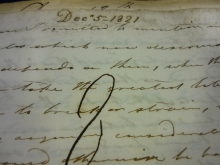The manuscripts of Edmund Nicholas Gabriel (1800-64)
We highlight some of the manuscripts held in our collection that belonged to Edmund Nicholas Gabriel, who was the first Secretary of the RCVS from 1844-1861.

In his Early history of veterinary literature Sir Frederick Smith says of Gabriel’s notes
“[that they] must have been made without Coleman’s’ knowledge; he openly indicated the offence it would give him if his lectures were published, and he rigidly excluded reporters”⊃1;
Smith then goes on to reproduce almost five pages of extracts from the notes including the following:
“bots produce no mischief; it is most unlikely that such an insignificant creature should be permitted by nature to destroy so noble an animal as the horse.”⊃2;
which he uses to illustrate his view that they
“show how limited was his [Coleman’s] knowledge of the most common, acute and fatal diseases of the horse."⊃3;
Other manuscripts by Gabriel in the Collection are:
- a book recording cases he attended during 1824-26 which includes, amongst others, details of a case labelled ‘Diseased kidney’ which describes a visit to a black mare belonging to the adjutant of the 61st Regiment of the Foot.
- notes made by Gabriel on various aspects of anatomy compiled from other sources
- notes for lectures on comparative anatomy that Gabriel delivered at the Plymouth Athenaeum between 1826 -30 covering topics such as bones of the head, the skeleton, digestive organs, general anatomy and zoology.
All of these manuscripts are written in Gabriel’s spidery, slightly illegible, handwriting which can also be seen in the early minute books of the RCVS where as Secretary he records the early deliberations of Council.

“active and energetic in mind, gentlemanly in his demeanour… respected most by those who knew him best."4
This portrait of Gabriel hangs on the wall of Belgravia House.
If you would like to view these, or any other item in the archives, please contact the Library at [email protected] or 020 7202 0752 to arrange an appointment.
References
1. Smith, Frederick (1930) Early History of Veterinary Literature: and its British development. Vol 3 London: Bailliere, Tindall and Cox. p19
2. Ibid p21
3. Ibid p21
4. Obituary: EN Gabriel The Veterinarian December (1864) p862